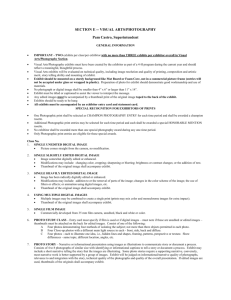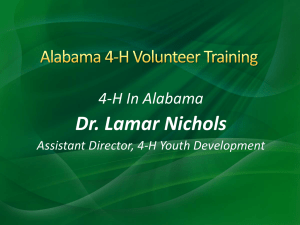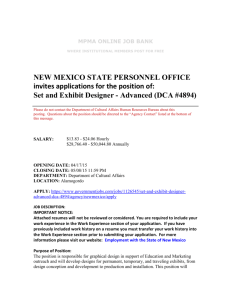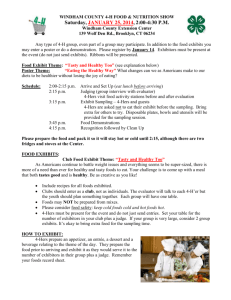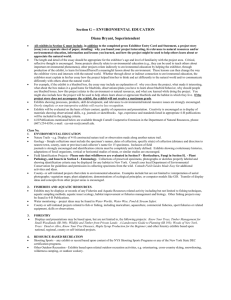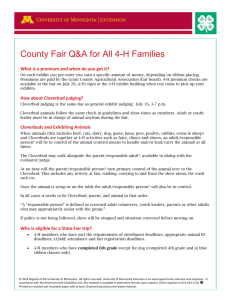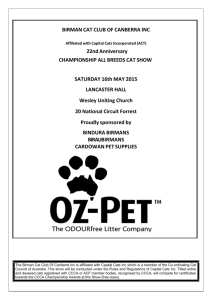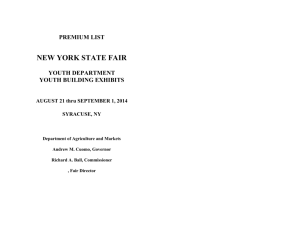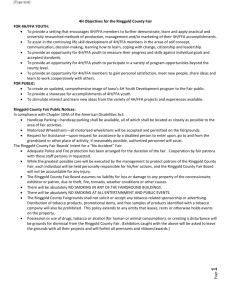Section J – STEM (Science, Technology, Engineering
advertisement
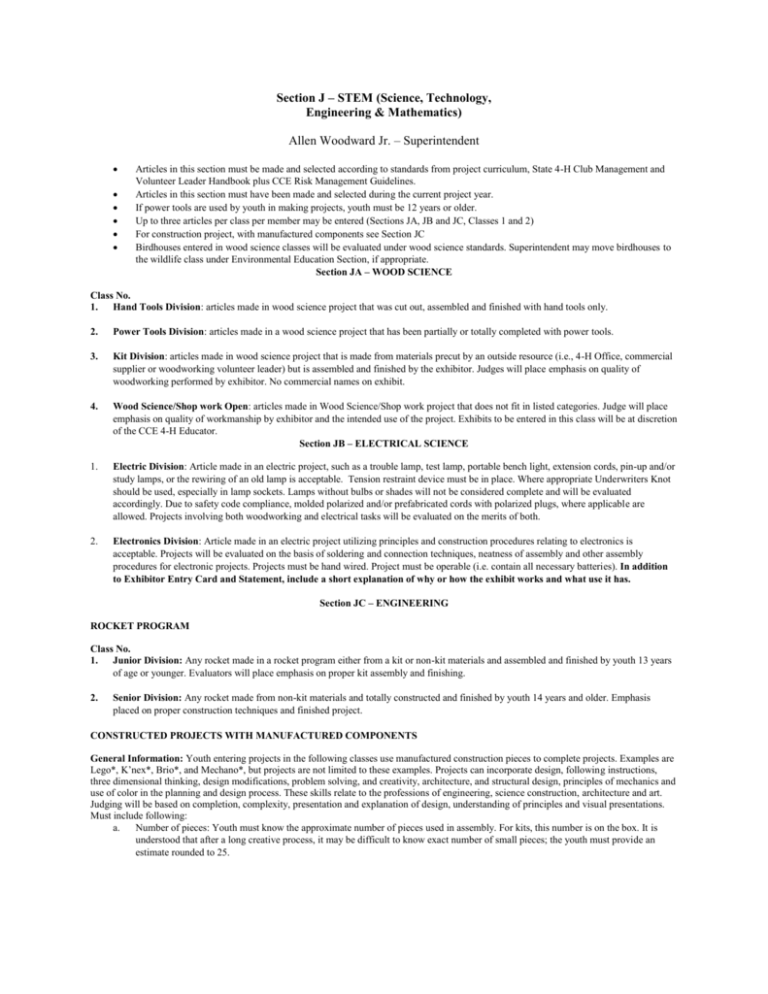
Section J – STEM (Science, Technology, Engineering & Mathematics) Allen Woodward Jr. – Superintendent Articles in this section must be made and selected according to standards from project curriculum, State 4-H Club Management and Volunteer Leader Handbook plus CCE Risk Management Guidelines. Articles in this section must have been made and selected during the current project year. If power tools are used by youth in making projects, youth must be 12 years or older. Up to three articles per class per member may be entered (Sections JA, JB and JC, Classes 1 and 2) For construction project, with manufactured components see Section JC Birdhouses entered in wood science classes will be evaluated under wood science standards. Superintendent may move birdhouses to the wildlife class under Environmental Education Section, if appropriate. Section JA – WOOD SCIENCE Class No. 1. Hand Tools Division: articles made in wood science project that was cut out, assembled and finished with hand tools only. 2. Power Tools Division: articles made in a wood science project that has been partially or totally completed with power tools. 3. Kit Division: articles made in wood science project that is made from materials precut by an outside resource (i.e., 4-H Office, commercial supplier or woodworking volunteer leader) but is assembled and finished by the exhibitor. Judges will place emphasis on quality of woodworking performed by exhibitor. No commercial names on exhibit. 4. Wood Science/Shop work Open: articles made in Wood Science/Shop work project that does not fit in listed categories. Judge will place emphasis on quality of workmanship by exhibitor and the intended use of the project. Exhibits to be entered in this class will be at discretion of the CCE 4-H Educator. Section JB – ELECTRICAL SCIENCE 1. Electric Division: Article made in an electric project, such as a trouble lamp, test lamp, portable bench light, extension cords, pin-up and/or study lamps, or the rewiring of an old lamp is acceptable. Tension restraint device must be in place. Where appropriate Underwriters Knot should be used, especially in lamp sockets. Lamps without bulbs or shades will not be considered complete and will be evaluated accordingly. Due to safety code compliance, molded polarized and/or prefabricated cords with polarized plugs, where applicable are allowed. Projects involving both woodworking and electrical tasks will be evaluated on the merits of both. 2. Electronics Division: Article made in an electric project utilizing principles and construction procedures relating to electronics is acceptable. Projects will be evaluated on the basis of soldering and connection techniques, neatness of assembly and other assembly procedures for electronic projects. Projects must be hand wired. Project must be operable (i.e. contain all necessary batteries). In addition to Exhibitor Entry Card and Statement, include a short explanation of why or how the exhibit works and what use it has. Section JC – ENGINEERING ROCKET PROGRAM Class No. 1. Junior Division: Any rocket made in a rocket program either from a kit or non-kit materials and assembled and finished by youth 13 years of age or younger. Evaluators will place emphasis on proper kit assembly and finishing. 2. Senior Division: Any rocket made from non-kit materials and totally constructed and finished by youth 14 years and older. Emphasis placed on proper construction techniques and finished project. CONSTRUCTED PROJECTS WITH MANUFACTURED COMPONENTS General Information: Youth entering projects in the following classes use manufactured construction pieces to complete projects. Examples are Lego*, K’nex*, Brio*, and Mechano*, but projects are not limited to these examples. Projects can incorporate design, following instructions, three dimensional thinking, design modifications, problem solving, and creativity, architecture, and structural design, principles of mechanics and use of color in the planning and design process. These skills relate to the professions of engineering, science construction, architecture and art. Judging will be based on completion, complexity, presentation and explanation of design, understanding of principles and visual presentations. Must include following: a. Number of pieces: Youth must know the approximate number of pieces used in assembly. For kits, this number is on the box. It is understood that after a long creative process, it may be difficult to know exact number of small pieces; the youth must provide an estimate rounded to 25. b. c. Diagram: Diagrams are required. A diagram could be a photograph printed on printer paper, a scale drawing on graph paper, a photocopy of an instruction sheet or a variable scale rough drawing. Relevant labels and explanation must be added. The diagram must include: 1. Name of youth; 2.The title of project; 3 the exact or approximate number of pieces and 4. A self-judgment of complexity level (a. easy – less than one hour to assemble; medium – 1-3 hours construction time or c. complex – more than 3 hours of construction time). Junior may use a photocopy of kit provided drawings for basis of their diagrams, but brand logo MUST be covered and not visible. The diagram can be displayed in a plastic stand, mounted on poster board or attached in a folder. Art value, ability or written work to attract, use of color and use of font add to design presentation. Protection: Youth may prepare a display box for the project. There is no evaluation or points for this box, it is merely protection. A simple box could be a cardboard box with two sides removed and replaced with clear plastic. Class No. 3. Kit: Restricted to juniors (ages 8-13) and exhibitors are limited to two projects in this class. If two projects are entered, they must differ significantly. Youth must enter a completed kit. Original story must describe design process, and play with model. Judging criteria: completion, complexity (number of pieces), diagram (of completed model and key elements labeled), explanation/story (explanation of the design process, difficulties, and interesting elements; describe play value, what steps could be taken to improve model) and overall presentation. 4. Original Model: Youth are limited to two projects in this class, projects must differ significantly. The project can be a scene, diorama, model, building, vehicle, plants or creature. Judging criteria: completion, design (number of pieces, moving parts – gear systems, axle systems (wheels), hidden entrances, pulleys, joints, projectiles and hinged components; unity of design – originality, use of color, symmetry of creativity, fully developed concept diagrams – comprehensive and detailed; an overall diagram of completed model with key elements labeled, of moving part(s) or independent component; explanation/written report – of design process, difficulties encountered and their solutions, description of play value, future expansion of project and overall presentation. 5. Model Demonstrating a Mechanical Science Concept: Projects must be original, no kits and can include level arms, gears, pulleys, friction, belts, airfoils (flight, wind), catapults and load bearing bridges and beams. Science concepts can include energy transfer, stress analysis, Newton’s Laws, gravity, etc…Entries in this class must include a working model, an equation describing a principle of science, a labeled diagram of the project and written explanation of the science involved. Evaluation will also include presentation and visual impact of the project. Youth may conduct experiments with model and provide written report. Judging criteria: working model that demonstrates a principle of mechanical science, must move or work as necessary, scientific equation that relates the principle, including clear definition of each term with equation displayed; labeled diagram provided that labels major parts of the model and also notes how parts or movement relates to equation; written report (no more than 2 pages) which explains the principle and how model illustrates the principle (may include additional page of experimental results using the model); written explanation that explains design and construction of the model, including any difficulties and how they were overcome, description of the principles of mechanical science that is demonstrated, clear understanding of scientific principles and explanation of how the model illustrates principle; and overall visual impact of project as prepared for display, including attractiveness of display. 6. Transportation Design: applies transportation pieces such as Brio* in which youth design a transportation system (road, railroad). Drawings are to be hand drawn. Judging criteria: Presentation labeled with name of exhibitor and title of project to include schematic of system drawn to scale, roads, railroads and bridges clearly labeled or identified in the legend, seniors to use 11x17 drawing paper, must have fully developed concept, clear details, completeness of system (no dead ends) and show creativity, legend that explains the meaning of symbols such as roads, railroads bridge, water, vegetation, buildings, written explanation that explains the design and purpose of the system, problems encountered and their solution and directions project could take in the future, and overall presentation, visual impact as prepared for display and attractiveness. ENGINEERING EDUCATIONAL DISPLAYS 7. Displays: may be a series of posters and a 3-demensional exhibit related to an engineering science project. Display should be selfexplanatory through use of signs or labels and limited to approximately card table size. Topics may include (but not limited to) engine parts or bicycle parts display boards, electric circuit boards, electric quiz games, safety rules for bicycling or working with wood or electricity. Entry will be evaluated on the purpose or principle idea, effectiveness in illustrating idea, appearance, arrangement and description of the display. RELATED ENGINEERING PROJECTS 8. Any article made as part of a directly related Engineering Science project, such as metal working, cardboard carpentry, and safety items and not included in classes 1-7. Counties may enter only ten articles in this class. Kits are not acceptable for senior division (14 years and over). Section JD – GEOSPATIAL SCIENCE Exhibits that show skills and knowledge learned through 4-H GPS and GIS projects. GIS maps: Maps made using ESRI (Environmental Systems Research Institute, Inc.) Arc GIS software or other mapping software. Criteria and Guidelines for Community Mapping Projects can be found on NYS 4-H web page. GIS map exhibits may be selected for display competition sponsored by NIFA and National Geographic Society. Class No. 1. GIS or GPS Project or activity: may be undertaken by individual or group. Exhibit may be in form of project record book, photo documentation, video, CD, DVD, etc… Exhibit must include project report documenting statements of purpose and outcome of project activity. 2. Story or Outline of a 4-H GIS or GPS Project: including photos, purpose of activity and summary of results. 3. Community Service/Youth Community Action Mapping Project: a mapping or GPS project built around a specific community issue or project. 4. Educational Poster Exhibit displaying 4-H GPS or GIS activities. 5. Public Presentation on 4-H and Geospatial Sciences. Section JE – RENEWABLE AND SUSTAINABLE ENERGY AND CLIMATE CHANGE Educational exhibits/display(s) describing your 4-H project work done in areas of Renewable Energy (solar, wind, geothermal, bio fuels, hydroelectric); Energy Conservation (home, school, community); Tracking (or studying) Climate Change; Activities/Studies related to managing “Carbon Footprints” in environment. Exhibits may consist of stationary or working models, posters, photo story/display or electronic media. Electronic media must be submitted on a storage device like a CD or flash drive. Information must be included on media to indicate method of viewing entry. A short description of what was undertaken in the project, your experience and what you learned through project must be included. This can be included in the entry itself or on the Exhibitor Information card. Note: some energy exhibits may fit in other classes – select only one class to enter your exhibit. Class No. 1. Renewable and Sustainable Energy 2. Climate Change Section JF – SCIENCE EXPERIMENTS AND EXHIBITS Individuals and groups are encouraged to enter exhibits/displays emphasizing what they learned and experienced in learning about science concepts in areas of agriculture, human ecology, life or physical sciences. Any type or combination of science projects along with creativity is encouraged. 1. Experiments: Describe your hypothesis (what you think will happen); describe the procedures you performed; describe the observations you made and what conclusions you drew from your experiment; include photos or drawings and samples (if possible) from your experiment. Use display board or poster board for display. Include experiment description, introduction, hypothesis, methods, results and your conclusions. 2. Public Service/Civic Engagement Projects: Exhibits can be of any public service or public education activity you took part in that had a scientific component. Examples may include watershed rehabilitation, recycling programs and educational models. Project exhibit posters/display must be clearly labeled with a written statement of what the project is, how it relates to science and why you are interested in the project. 3. Descriptive Science: Science projects that are not experiments and service projects but do consist of systematic observations and tell us about the natural world. Exhibit could show summaries of what you observed (ex: how the local bird population changes with the seasons, where flies like to breed in a barn, how many bites of food different animals eat per minute). Could present collections and classifications of materials which display physical or biological articles. 4. Citizen Science: is the engagement of public participants in real-world scientific collaborations – asking questions, collecting data, and/or interpreting results. A display or record of participation in a Citizen Science project, could be part of a local, regional, national or international project, but needs to include some kind of connection to scientists, researchers, or, policy makers and contribute to scientific knowledge that will be put to some type of use (by researcher, policy makers, etc. ) Examples include: Wasp Watchers, Project Feeder Watch, eBird, Lost Ladybug, Adopt a Pixel, Nature’s Notebook, or a local project. For more information: http://www.birds.cornell.edu/citscitoolkit/contexts/youth-development/4-h/

